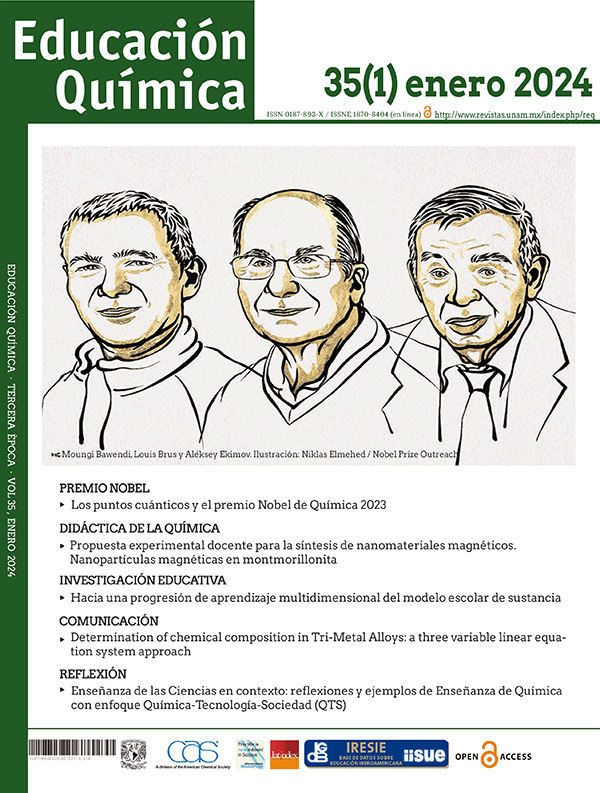Quantum dots and the Nobel Prize in chemistry 2023
Main Article Content
Abstract
The 2023 Nobel Prize in chemistry was awarded to 3 researchers, Alexei Ekimov, Luis Brus, and Moungi Bawendi, for their contributions to the discovery, characterization, and control of the production of quantum dots. Quantum dots are semiconductor nanostructures that exhibit quantum properties, i.e., size-dependent properties. According to these contributions to knowledge, since the mid-90s, these nanoparticles have had various technological applications, such as in the electronics and optics industry, as well as in medicine, production of substances, sensors, and energy conversion. , among others. This manuscript seeks to give a general look at quantum dots' chemical and physical properties, the contributions of award-winning researchers in this field, and our own experience in using these particles for sensor purposes of reactive substances.
Article Details
Citas en Dimensions Service
References
Charles P. Poole J, O. F. (2003). Introduction to nanotechnology. United States of America. Nanoscience and nanotechnologies: opportunities and uncertainties,. New York: The Royal Society & the Royal Academy of Engineering.
Brus, L. E. (1983). A simple model for the ionization potential, electron affinity, and aqueous redox potentials of small semiconductor cristallites. J. Chem. Phys., 79, 5566-5571.
C. B. Murray, D. J. (1993). Synthesis and characterization of nearly monodisperse CdE (E = sulfur, selenium, tellurium) semiconductor nanocristallites. Journa of the American Chemical Society, 19, 8706-8715.
Emilio Navarrete S., J. R. (2019). Chemometric approach to study the influence of synthesis parameters on the size of CdTe quantum dots obtained from aqueous solutions. Arabian Journal of Chemistry, 12, 5103-5110.
Eduardo Muñoz, J. P.-P. (2019). Interaction between nitroxyl radicals and CdTe quantum dots: T Determination of fluorescence-quenching mechanisms in aqueous solution. Journal of Photochemistry & Photobiology A: Chemistry, 383, 112024.
Eduardo Muñoz, R. M. (2021). Hydroxyl Radicals Attack CdTe Quantum Dots. Journal of The Electrochemical Society, 168, 097503.
Amin Salehi-Khojin, W. Z. (2012). Nanotubes throw their heat around. Nature Nanotechnology, 7, 280-281.
Bajpayee AG, W. C. (2014). Avidin as a model for charge driven transport into cartilage and drug delivery for treating early stage post-traumatic osteoarthritis. Biomaterials, 35, 538-549.
Chaniotakis, M. F. (2009). Semiconductor quantum dots in chemical sensors and biosensors. Sensors, 9(9), 7266-7286.
Chittreeya Tansakul, E. L. (2010). Distance-Dependent Fluorescence Quenching and Binding of CdSe Quantum Dots by Functionalized Nitroxide Radicals. J. Phys. Chem. C, 114, 7793-7805.
D. J. Norris, M. N. (1993). Size dependent optical spectroscopy of II–VI semiconductor nanocrystallites (quantum dots). Z. Phys. D., 26, 355-357.
Ekimov, A. I. (1981). Quantum Size Effect in Three-Dimensional Microscopic Semiconductor Crystals. JETP Lett., 34, 345-349.
Hilmi Volkan Demir, S. N. (2011). Quantum dot integrated LEDs using photonic and excitonic color conversion. Nano Today, 6, 632-647.
K. Tanabe, D. G. (2011). Fabrication of electrically pumped InAs/GaAs quantum dot lasers on Si substrates by Au‐mediated wafer bonding. Phy. Status Solidi, 8, 319-321.
Lemon CM, C. P. (2014). Metabolic tumor profiling with pH, oxygen, and glucose chemosensors on a quantum dot scaffold. Inorg. Chem., 53, 1900-1915.
Maureen A. Walling, J. A. (2009). Quantum Dots for Live Cell and In Vivo Imaging. Int. J. Mol. Sci., 10, 355-357.
P. Kamat, K. T. (2010). Beyond Photovoltaics: Semiconductor Nanoarchitectures for Liquid-Junction Solar Cells. Chem. Rev., 110, 6664-6688.
Pombo Barros, V. y. (2011). QUANTUM DOTS: THE NEW CONTRIBUTION OF NANOTECHNOLOGY TO RESEARCH AND MEDICINE. Revista Complutense de Ciencias Veterinarias, 5, 69-102.
R. Debnath, J. T.-A. (2010). Ambient-processed colloidal quantum dot solar cells via individual pre-encapsulation of nanoparticles. J. Am. Chem. Soc., 132, 5952-5953.
R. Dingle, W. W. (1974). Quantum States of Confined Carriers in Very Thin Al x Ga 1 − x As -GaAs- Al x Ga 1 − x As Heterostructures. Physical Review Letters, 33, 827-830.
Xinkun Li, P. J. (2011). A high-performance quantum dot superluminescent diode with a two-section structure. Nanoscale Research Letters, 6, 625.

Educación Química por Universidad Nacional Autónoma de México se distribuye bajo una Licencia Creative Commons Atribución-NoComercial-SinDerivar 4.0 Internacional.
Basada en una obra en http://www.revistas.unam.mx/index.php/req.




